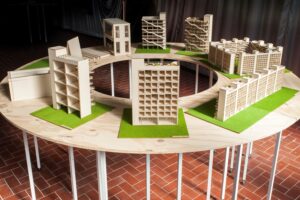The project at a glance
-
Start date:01 Oct 2017
-
Duration in months:58
-
Funding:FEDER – Fonds Européen de Développement Régional <br>Investissement pour la croissance et l’emploi (2014-2020)
-
Principal Investigator(s):Markus Schäfer
About
Over the last decades, Luxembourg has experienced a strong environmental pressure from the construction sector: the exponential growth has had a tremendous impact on the real estate market and resource consumption. In addition, buildings are often demolished due to conversion or change of the architectural design although the supporting structure remains undamaged. This leads to vast quantities of waste which need to be discharged. Thus, the building sector is generating a large amount of CO2 emissions, resource consumption and waste production – new eco-construction approaches are needed. A group of professors from the Department of Engineering in collaboration with the architect and Prof. Hertweck and a team of eight researchers decided to join efforts to develop in a holistic way new building components, analytical tools, methods and design models for resource and energy efficient buildings. The project was organised around seven workpackages: WP1 exploited new architectural typologies which allow deconstruction and reconstruction or reutilisation of the same structural component for other buildings adapting to future requirements. These typologies can benefit from new demountable connection systems between concrete slabs and steel or wood beams, that allow for easy assembly/disassembly and therefore reuse (WP2-3). Reuse of components can be impeded by their degradation, therefore WP4 developed models and simulated the degradation of concrete for the better understanding of its long-term properties and reusability. Different building elements in modular architecture have different environmental performances, WP5 investigated this. Finally, WP6-7, of transversal nature, focused on the concept of material and component bank mandatory to promote recycling and reuse of materials and components, and proposed a digital decision-making workflow for the identification of the potential reuse or recycling of a particular material or component.
Organisation and Partners
- Biomedical Data Science
- Department of Education and Social Work
- Department of Engineering
- Faculty of Humanities, Education and Social Sciences (FHSE)
- Faculty of Science, Technology and Medicine (FSTM)
- Structural Engineering & Composite Structures (SECS)
Project team
-
Markus Schäfer
-
Frank Scholzen
-
Florian Hertweck
-
Michael Scheuern
-
Andreas Zilian
